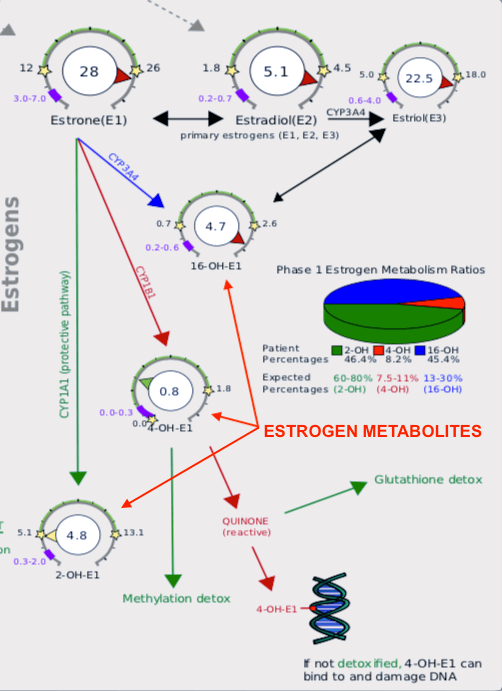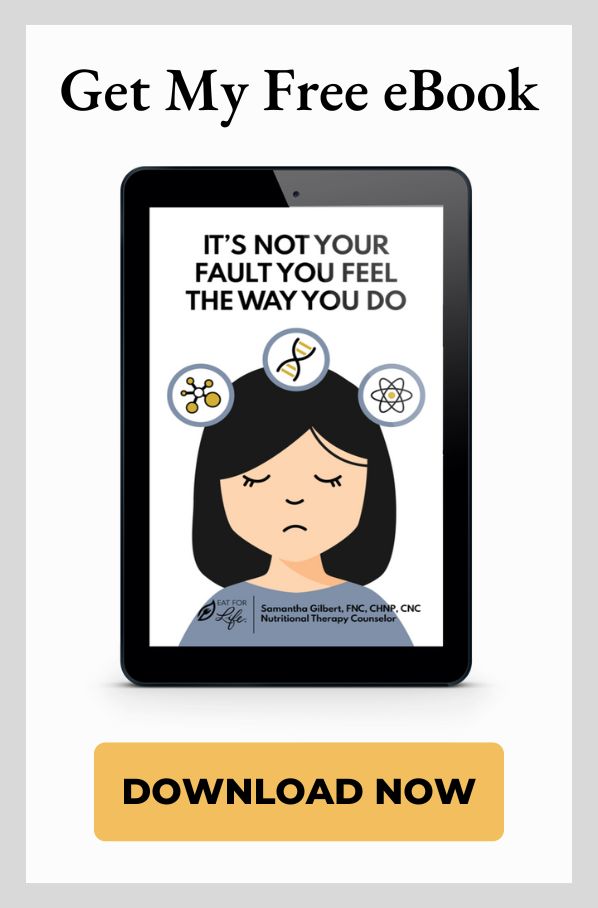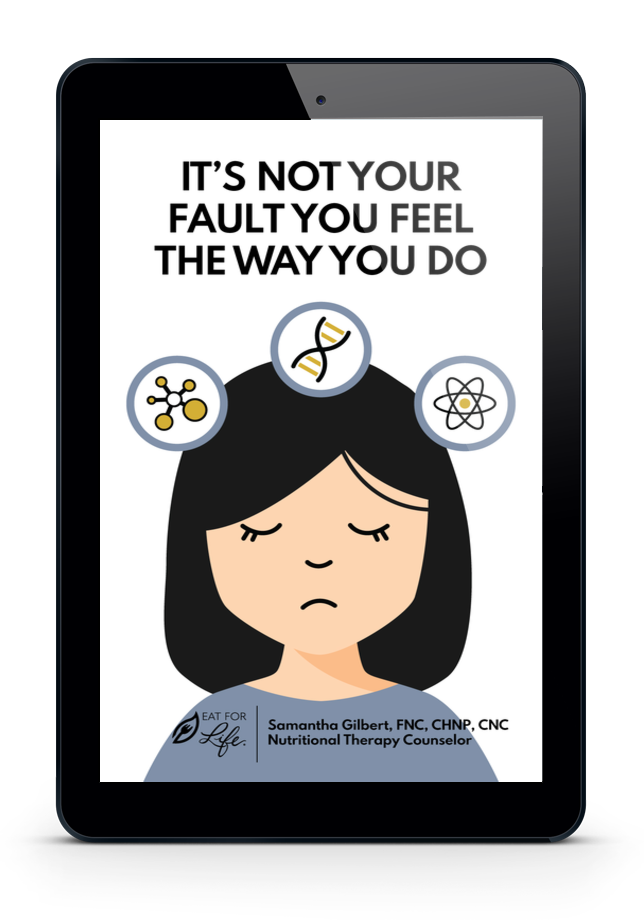Since the Women’s Health Initiative (WHI) study first came out in 2002, estrogen has gotten a bad rap and created a lot of fear and confusion in women all over the world.
Though well-intentioned, WHI lead investigators have backed down from many of their positions because they realized their fundamental conclusions were misused and really not valid, but unfortunately, the word had already gotten out that estrogen causes breast cancer and coronary heart disease, and is to be avoided. As you will see, the truth about estrogen is quite different.
To learn more about estrogen, perimenopause and menopause, check out my podcast episode 45 below with Dr. Felice Gersh, founder and director of the Integrative Medical Group of Irvine. You can also find the Eat For Life podcast on Apple Podcasts, Spotify, Google Podcasts, or wherever you listen to podcasts!
Women’s Health Initiative Study Flaws
The WHI study participants received conjugated equine estrogens, plus medroxyprogesterone acetate, which was the prevalent hormonal therapy at that time and decades before we had the ability to create human bioidentical hormones. The average age was 50-79 years of age.
Our bodies do not recognize estrogens from recycled horse piss!
These were hormones that came from a pregnant mare’s urine that was then dried and put into a tablet. Conjugated means the hormones had already passed through the liver and gone through the process of biotransformation. Conjugation is how the body converts something fat-soluble into something water-soluble, so it can be eliminated in water (urine) to get out via the kidneys. It’s already been modified, meaning the horse didn’t even want it anymore!
Plus it came with an array of other byproducts and all kinds of estrogens that are never found in a human. When ingested, this type of estrogen gets modified by the human digestive tract and liver. Then it goes into the bloodstream with a whole array of deranged types of chemical hormones. The dominant one that’s similar to the human type is estrone, which works predominantly on the alpha receptor.
The estrogen made by human ovaries is 17β-Estradiol (17-beta estradiol), which has a balanced effect on all the different estrogen receptors. Whereas the estrone that’s getting into the bloodstream only predominantly works on one, creating myriad imbalances in the body.
The three types of estrogen made in the human body and their preference for binding to certain receptors are:
- E1 (estrone) binds preferentially to the alpha receptor (ERα)
- E2 (estradiol) binds equally well to both the alpha and beta receptors (ERα & ERβ)
- E3 (estriol) binds preferentially to the beta receptor (ERβ)
So in essence, with estrone, you have this imbalance of estrogen working predominantly on only one receptor, which creates a completely unnatural effect in the human body.
They added in progestin, an endocrine disruptor
These deranged estrogens were also combined with medroxyprogesterone acetate, (progestin, brand name Provera). Progestin is a man-made word for an endocrine disruptor for progesterone. An endocrine disruptor is something that works on receptors for that hormone, but in a very different way than the natural hormone. In some organs it might be an antagonist, in others, it acts as a mimic. It can also interfere with the production, distribution, degradation, and storage of hormones. Many people call this medroxyprogesterone acetate progesterone but it’s not actually progesterone.
They didn’t follow a woman’s natural menstrual cycle
The WHI used this combination of hormones that would never exist in a human female at any stage, and they gave them in a way that’s not physiologic. In other words, they gave the exact same dose every single day.
The human female body was beautifully and intelligently designed. Every woman knows that their menstrual cycle is a rhythm of hormones that go up and down, regulating hormone receptors, tumor suppressors, and gene expression. It’s a complex ecosystem that works in harmony with every other system in the body including stress hormones, neurotransmitters, and enzymes, to name a few.
So they gave something that was alien to the female human body, which changed gene expression and included the rejected estrogen byproducts of a pregnant horse, combined with a chemical endocrine disruptor for progesterone.
We now know that conjugated equine estrogen quadrupled the risk of blood clotting because of the effects through the liver, and the fact that it only predominantly works on the alpha receptor. Unfortunately, everything about this study used the wrong products, which has created a lot of fear and harmed women for the past 20 years.
The medical establishment just can’t get it out of their head that estrogen is a killer. When you take a good look at all the diseases of aging, they’re really the diseases of deficiencies and imbalances, which have a significant impact on ovarian function.
Perimenopause vs Menopause
Perimenopause often starts between the ages of 40 to 45 but can begin in some women as early as their 30s. The first signs of perimenopause are myriad changes in cycle length and menstrual flow, with sporadic surges in estrogen. Progesterone levels tend to start dropping off around the age of 35.
Perimenopause symptoms include irregular periods that can be heavy one month and light the next and can often skip a month. If it’s been more than 60 days since your last menstrual cycle, you’re probably in late perimenopause.
Other symptoms of perimenopause include:
| Anxiety, depression, and mood challenges Insomnia and hot flashes Changes in libido | Fluctuating cholesterol More urgency to urinate Leaky gut and microbiome changes | Vaginal changes and atrophy Weight gain despite diet and exercise Dry skin, rosacea, acne, and broken blood vessels |
The main difference between perimenopause and menopause is menstruation. If you’ve completed 12 consecutive months without a menstrual period, you are officially in menopause and the perimenopause period has concluded. As hormone levels continue to decline, symptoms become more pronounced, and as you’ll see, without support, risk factors increase significantly.
How Estrogen Protects Women
17β-Estradiol combined with progesterone in the proper cycling is incredibly protective.
The Way Menstruation Works
With the menstrual cycle, you have different levels of estrogen being produced by the ovaries. Day one of the menstrual cycle is the first day of bleeding. At that point, estrogen is at its lowest of the entire menstrual cycle, and it’s also a time of inflammation. This is because the uterine lining is dying. It’s dead and it has to come out, which creates inflammation with a bit of cramping. This uterine contraction helps to push out this dying tissue (like a mini labor) and is completely normal.
Then estrogen levels start to rise and become less inflammatory leading to a big spike of luteinizing hormone (LH), the hormone coming from the pituitary gland in the brain that triggers ovulation at the time that estrogen is at its highest. This is actually the most anti-inflammatory time, which downregulates innate immune cells so they don’t attack and kill the sperm that are coming in. In fact, it’s an amazing modulator, which allows reproductive success so that we don’t kill the sperm and we don’t kill the embryo, yet we can still fight infections.
The immune system of females is incredible. We have menstrual cycles where the dying lining of the uterus comes out and with that big spike of estrogen, actually turns on a tumor suppressor gene. So our bodies were built to prevent breast cancer, not to create breast cancer. Statistically, the vast majority of breast cancers occur in post-menopausal women with very low estrogen levels.
The reason there’s been a serious increase in the incidents of premenopausal breast cancer is because of the ubiquitous endocrine disruptors, the chemicals that surround us that interfere with the normal hormonal signaling of our bodies. Add to this the fact that so many teenagers and young women are on hormonal contraceptives (often for decades) that significantly alter these rhythms and suppress estrogen, progesterone, and testosterone levels.
Also, the pill also has a mild antibiotic in it, which is why leaky gut and microbiome issues are so prevalent in women on the birth control pill. According to research published in the New England Journal of Medicine, women who use some type of hormonal contraception have a 20% increased risk of breast cancer.
Additionally, I see a lot of hysterectomies being performed on very young women that throw them into early menopause. Sadly, this is often done without looking at root causes and lifestyle factors. Then we have circadian rhythm dysfunction and poor nutrition, which leads to gut microbiome insults and further hormonal dysregulation. And let’s not forget about the impact breast implants have on hormones and the immune system. You can read more about that here.
Progesterone is also an immunomodulator. When progesterone is at its peak in the luteal phase, it also works on tumor suppressor genes. Both estrogen and progesterone have tremendous effects on the immune system, but when this delicate balance is altered by epigenetic and environmental insults, the negative effects can be tremendous.
Estrogen is Critical for the Body to Function Optimally
Estrogen is the mother healer connected to growth, nurturing, and proliferation. It produces and stimulates growth factors that are part of healing, producing new blood vessels (called angiogenesis), so that you can heal. This is why elderly people don’t heal as well as young people.
Estrogen protects against bone loss and heart disease, controls cholesterol levels, supports neurotransmitter production and a positive mood, protects against high blood pressure, strokes, and ruptured aneurysms (postmenopausal women surpass men in these areas), and supports gut microbiome integrity and skin health.
Estrogen acts as the gas and progesterone acts as the breaks, so they need to be in balance with one another. For example, women in menopause tend to accumulate much more inflammatory, visceral fat tissue because estrogen is also in control of fat deposition. Fat has an enzyme called aromatase that can convert androgens. A bit comes from the ovaries but most comes from the adrenal glands, which can then convert into predominantly estrone. After menopause, especially in women who have too much visceral fat, you have the production of estrone in peripheral tissues.
Estrogen and Cancer
As I shared previously, estrone effects predominantly on the alpha receptor and this is what has been shown in estrogen receptor-positive breast cancer. In fact, estrogen receptors are overexpressed in around 70% of breast cancer cases, referred to as ER-positive.
Inflammation upregulates the activity of the aromatase enzyme in fat tissue, which is nature’s way of helping to protect the body from various insults because estrogen as an immunomodulator actually controls the immune cells. They turn them on so that they can attack invading pathogens or deal with trauma. Then estrogen flips the switch to reduce the inflammatory response.
This is why aging is often called inflamm-aging and women who are in menopause are in this pro-inflammatory state, which has many other contributors like gut microbiome changes and autoimmunity. This is the perfect ticket to cancer because inflammation causes DNA breakage and estrogen is now hijacked. Then you have an alteration of gene expression and estrogen that’s now supporting the growth of cancer.
Everything is about survival for reproductive health. But after menopause, everything is turned on its head and now you have this chronic state of inflammation and this upregulation of aromatase enzyme making more estrogen, which only works predominantly on the alpha receptor, which is the ticket for trouble in the uterus.
The Estrogen Copper Connection
I’d be remiss if I didn’t mention the connection between copper and estrogen. For over a decade, I’ve been writing, teaching, and helping women recover from copper toxicity, another pro-inflammatory, high oxidative stress condition.
Women that do not tolerate any form of estrogen are almost always overloaded in copper. If you have a history of estrogen intolerance (hormonal contraceptives, copper IUD, HRT), postpartum depression or psychosis, or depression and high anxiety brought on by hormonal events such as puberty and pregnancy, you may be overloaded in copper. Click here to learn more about copper overload and why I always test it in my clinic.
Please note I am a big fan of the tremendous benefits of bioidentical hormone therapy (BHRT) but the dose and timing will always vary, especially if a woman is copper toxic. I have found that dietary and nutrient therapy, as well as lifestyle factors, are incredibly important in balancing copper and zinc before embarking on BHRT. Of course, the approach will be different for every woman.
Hormone Testing for Perimenopause and Menopause
The gold standard for initial hormone testing is the DUTCH hormone test by Precision Analytical, which is the one I use in my clinic. DUTCH stands for Dried Urine Test For Comprehensive Hormones. My clients collect just four or five dried urine samples over a 24-hour period, which gives us a very comprehensive overview of their hormone status.
The complete version tests the following:
- HPA Axis markers (cortisol, cortisone, DHEA – and their metabolites)
- Sex Hormone markers (estrogen, progesterone, testosterone – and their metabolites)
- Extras (melatonin, 8-OhdG, nutritional organic acids, and neurotransmitter metabolites)
The DUTCH provides greater accuracy in measuring estrogen levels because estradiol levels are about 1,000 times higher in urine than in saliva, so urine is a more accurate way to measure estradiol levels. While knowing how much of a hormone the body is making is important, knowing how the body is processing a hormone is even more critical. The estrogen metabolites tell us if the body is metabolizing estrogen in a way that’s protective or harmful. We can look at the Phase I metabolites and see if the body is making more protective 2-OH metabolites or more potentially carcinogenic 4-OH metabolites. Then, we can look at the Phase II metabolites and see if the body is sufficiently neutralizing those 4-OH metabolites. The DUTCH test measures 10 different estrogen metabolites.

Urine is one of my favorite ways to evaluate initial estrogen status because it provides information about estrogen levels and estrogen detoxification. If estrogen levels are good, but the body is metabolizing estrogen in a harmful manner, a woman could have symptoms of estrogen dominance and a greater risk of cancer.
The progesterone metabolites tell us if a woman might benefit from oral or sublingual progesterone therapy (instead of or in addition to a topical cream) and whether her low progesterone may be a factor in her anxiety or insomnia.
The testosterone metabolites tell us if androgens are being turned into more potent androgens which could cause symptoms such as facial hair in women and prostate issues in men and whether testosterone therapy is working.
Additional and very helpful serum levels that are not part of the DUTCH include LH (Luteinizing Hormone), FSH (Follicle-Stimulating Hormone), Prolactin, and SHBG (Sex Hormone Binding Globulin). Saliva testing is another good option. I often use it after BHRT has commenced but it can be done beforehand as well.
We have to think of menopause and perimenopause in a completely different light. It’s not just about loss of reproductive functions. It’s about the loss of metabolic homeostasis and the start of the accelerated aging processes throughout every organ system in the female body that can lead to a lack of thriving in midlife and beyond.
Nutrition Counseling To Help You Thrive
If you’d like to understand why your hormones may not be functioning properly, let’s look at identifying and addressing the root biochemical causes and imbalances of your symptoms, which includes testing and analysis.
I offer a free 1:1 consultation to help you disconnect from the hype and the marketing jargon, and address the true source(s) of your discomfort. It’s time for your healing journey to truly begin.







One Response
I’m 64, had total hysterectomy 20yrs.ago, over past 2years stressful divorce & saleof estate. When made move to MT from TX June of 22 diagnosed DCIS & had lumpectomy at 0 stage cancer. I refused radiation & chose hormone receptor therapy. One month 20mg. Tamoxifen made me so ill i couldnt manage. Now one week of anastrozole 1mg. Would you have had radiation with my diagnosis. Would love consulting with Dr. Gersch for opinion, am I on the right path.